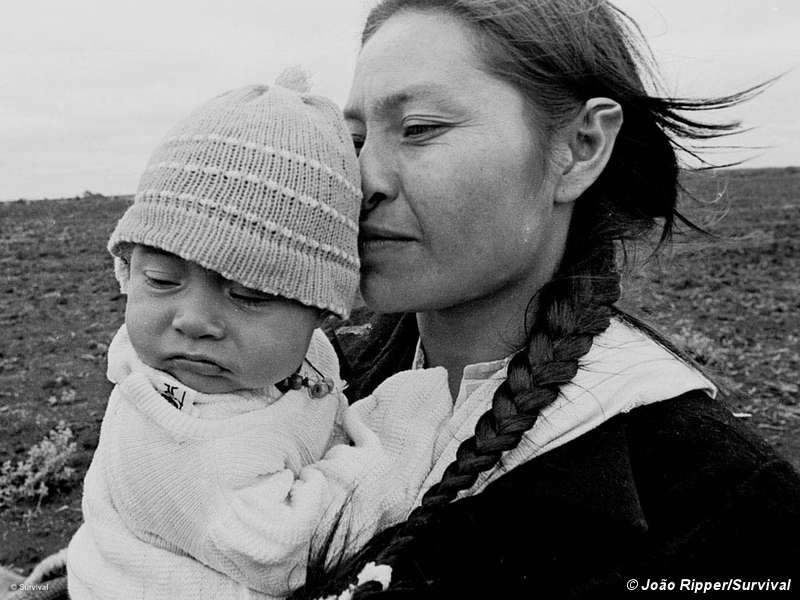Canto Kaiowá
História e cultura indígena
gravado por índios: Guarani-Kaiowá
local: Mato Grosso do Sul
2000
gravado por índios: Guarani-Kaiowá
local: Mato Grosso do Sul
2000
Tracks:
01. Mensagem do Cacique Getúlio: Yvyraija xe mbojeroky
02. Oje rokýivetei katu ra'e
03. Gwyra rupa gwyra rupapy-mo jaju
04. O gwahe jevy-ma niko gwyra
05. Xe mbojeroky-ta tipo ra'e
06. Jaju apyka rupa jaju apyka rupa-py jaju
07. No'ã nhane rembipapa ra'e he gwyra gwahu katu ra'e
08. Háta xe ave
09. Ndopo ijeroky
10. Nhambojegwa jevy-ma gwyra
11. Xe mbojeroky-ko marakanã
♫☆`*♥¸¸.•*¨*•♫☆`*♥¸¸.•*¨*•♫
♫☆`*♥¸¸.•*¨*•☆♫`*♥¸¸.•*¨*•♫
“Canto Kaiowá - História e cultura indígena” (Kaiowá Chant - Indigenous history and culture) is an album featuring indigenous chants of the Kaiowá people made and recorded by the anthropologist Pierre Clastres, in the village Jaguapiru, part of the Indigenous Reservation of Dourados. It was recorded and released in 2000.
Pierre Clastres said about the Kaiowá: “…in few peoples is witnessed a religion so intensely lived: ‘we want to be gods’, they say; ‘but we are only men’”.
***
Introduction
Three aspects of Guarani life express an identity that gives them a specificity among other indigenous peoples, shaping and creating a “Guarani way of being": a) the ava ñe'ë (ava: Guarani person, man; ñe'ë: a word that is confused with "soul") or speech, language, that defines identity in verbal communication; b) the tamõi (grandfather) or common mythical ancestors and c) the ava reko (teko: "being/essence, state of life, condition, custom, law, habit") or behavior in society, which is sustained through a mythological and ideological framework. These aspects inform the ava (Guarani Man) how to understand experienced situations and the world that surrounds him/her, providing guidelines and reference points for his/her social conduct (Susnik, 1980:12).
There are, however, differences among the Guarani subgroups living in Brazil – the Ñandeva, Kaiowa and Mbya, differences in the linguistic forms, customs, ritual practices, social and political organization, religious orientation, as well as specific forms for interpreting the reality they experience and for interacting according to situations in their history and their present-day circumstances. This entry provides information specifically on the Ñandeva and Kaiowa groups. There is a specific entry on the Mbya Guarani.
Three aspects of Guarani life express an identity that gives them a specificity among other indigenous peoples, shaping and creating a “Guarani way of being": a) the ava ñe'ë (ava: Guarani person, man; ñe'ë: a word that is confused with "soul") or speech, language, that defines identity in verbal communication; b) the tamõi (grandfather) or common mythical ancestors and c) the ava reko (teko: "being/essence, state of life, condition, custom, law, habit") or behavior in society, which is sustained through a mythological and ideological framework. These aspects inform the ava (Guarani Man) how to understand experienced situations and the world that surrounds him/her, providing guidelines and reference points for his/her social conduct (Susnik, 1980:12).
There are, however, differences among the Guarani subgroups living in Brazil – the Ñandeva, Kaiowa and Mbya, differences in the linguistic forms, customs, ritual practices, social and political organization, religious orientation, as well as specific forms for interpreting the reality they experience and for interacting according to situations in their history and their present-day circumstances. This entry provides information specifically on the Ñandeva and Kaiowa groups. There is a specific entry on the Mbya Guarani.
The ceremony in itself, guided by a religious leader, begins at sundown and ends at dawn on the following day. This shaman must know the mborahéi puku or “long song”, the verses of which, not repeated, cannot be interrupted after the ceremony has begun. Each verse chanted by the ñanderu is repeated by the community, always accompanied by the mbaraka made and used by the men and the takuapu used by women. At dawn, having finished the mborahéi puku (long song), there is the baptism of the harvest (manioc, sugar cane, pumpkin, sweet potato, corn etc.), which has remained on the altar. On the following night the ceremony of avati kyry continues with songs and secular dances, the kotyhu and the guahu, performed by the whole community and by many visitors who participate in the ceremony.
♥












































































+Front.jpg)

















